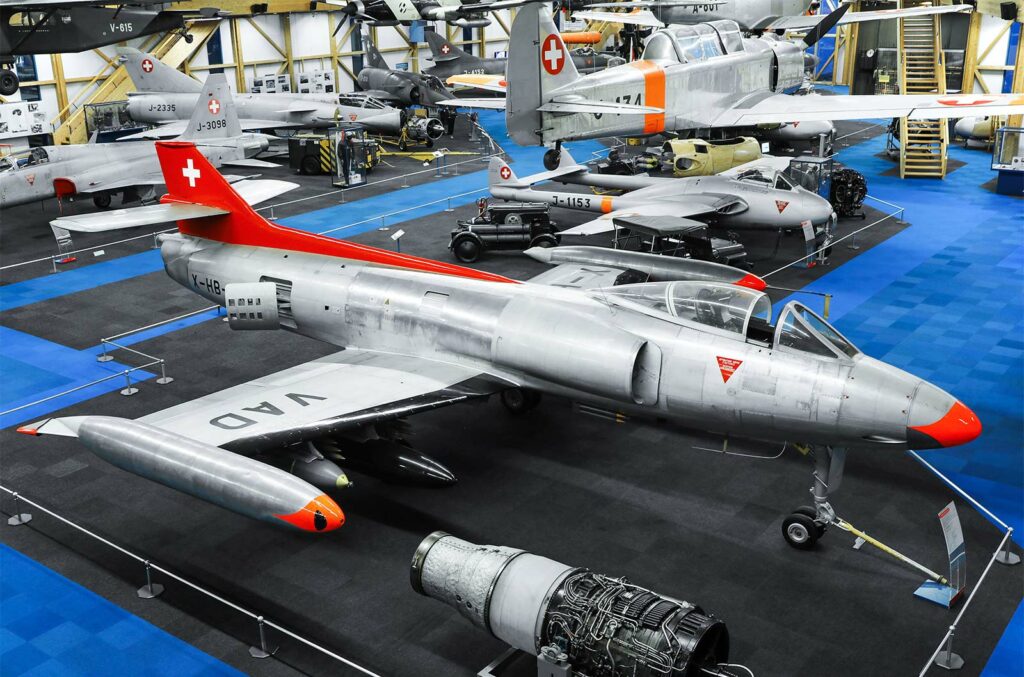Swiss-made FFA P-16, an early jet fighter prototype, known for its ground-attack capabilities and advanced design for its era.
In brief
The FFA P-16, developed by Flug- und Fahrzeugwerke Altenrhein AG in Switzerland, was an experimental jet fighter aircraft primarily designed for ground attack roles. First flown in the 1950s, it was a pioneering project in Swiss aviation, aimed at creating a domestic jet fighter that could operate from short, rough airfields. The P-16 featured a robust, straightforward design with an emphasis on durability and ease of maintenance. Despite its innovative aspects and promising performance, the P-16 program was eventually discontinued due to various political and financial reasons, with only a limited number of prototypes built.
The FFA P-16 represents a significant chapter in the history of Swiss aviation as an ambitious attempt to develop a homegrown jet fighter.
History of the Development of the FFA P-16
In the context of the Cold War and the increasing importance of air power, Switzerland recognized the need for a modern jet fighter to replace its aging fleet of piston-engined aircraft. The Flug- und Fahrzeugwerke Altenrhein AG (FFA) embarked on the development of the P-16, aiming to create a jet capable of ground-attack missions and operating from short airfields.
The P-16 program was launched in the early 1950s, marking Switzerland’s foray into the development of jet-powered military aircraft. The project’s objective was to produce an aircraft that was not only effective in its designated role but also simple to maintain and operate in the diverse Swiss terrain.
The first prototype of the P-16 took to the skies in 1955. The program, however, faced challenges, including technical issues and budget constraints. Despite these difficulties, the P-16 demonstrated significant potential in its test flights.
Design of the FFA P-16
The FFA P-16 was designed with a focus on ruggedness and operational flexibility. It featured a swept-wing design and was powered by a single jet engine. The aircraft’s airframe was constructed to withstand the rigors of high-speed, low-altitude flight and short takeoff and landing (STOL) operations. The P-16’s design included innovations in aerodynamics and aircraft systems, aiming to enhance its performance and reliability.
One of the key design aspects of the P-16 was its ability to operate from short, unprepared airstrips, a requirement due to Switzerland’s mountainous terrain and the need for dispersed air operations in case of conflict.

Performance of the FFA P-16
The FFA P-16’s performance was notable for its era. It was equipped with a jet engine that provided it with a top speed and agility competitive with other contemporary jet fighters. The aircraft’s range, ceiling, and payload were designed to meet the specific requirements of the Swiss Air Force, with a focus on ground-attack missions.
In comparison to its contemporaries, the P-16 showed promise in terms of speed, maneuverability, and STOL capabilities. However, the program’s termination meant that its full operational potential was never realized.
Variants of the FFA P-16
The FFA P-16 program produced a few prototypes, each incorporating improvements and modifications based on testing and evaluation. These variants demonstrated the evolution of the design and the efforts to refine the aircraft’s capabilities.
Military Use and Combat of the FFA P-16
The FFA P-16 was not adopted for active service and did not see combat. The limited number of prototypes were used primarily for testing and evaluation. The P-16’s development was closely watched by the Swiss Air Force, but the decision was ultimately made not to proceed with large-scale production.
The FFA P-16 remains an important part of Swiss aviation history. Although it never entered full-scale production or combat, the P-16 was a symbol of Switzerland’s capability and ambition in aircraft development during the early jet era. Its legacy lies in its contribution to Swiss aerospace engineering and the lessons learned from its development.
Back to the experimental aircraft section.